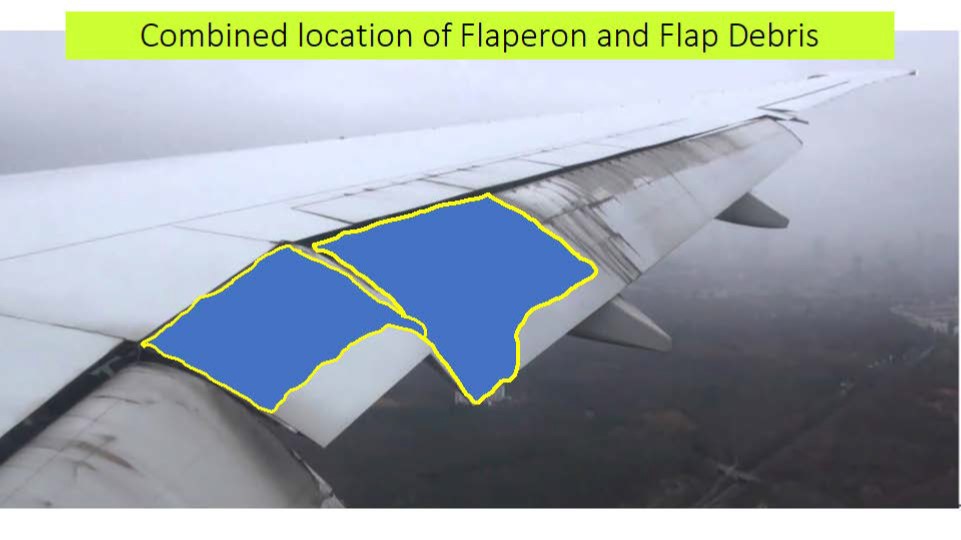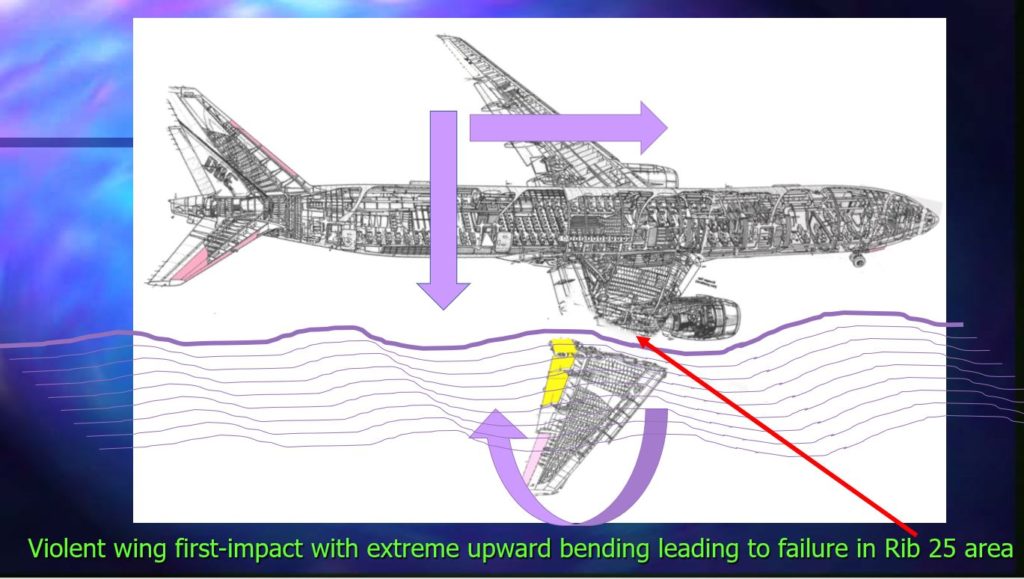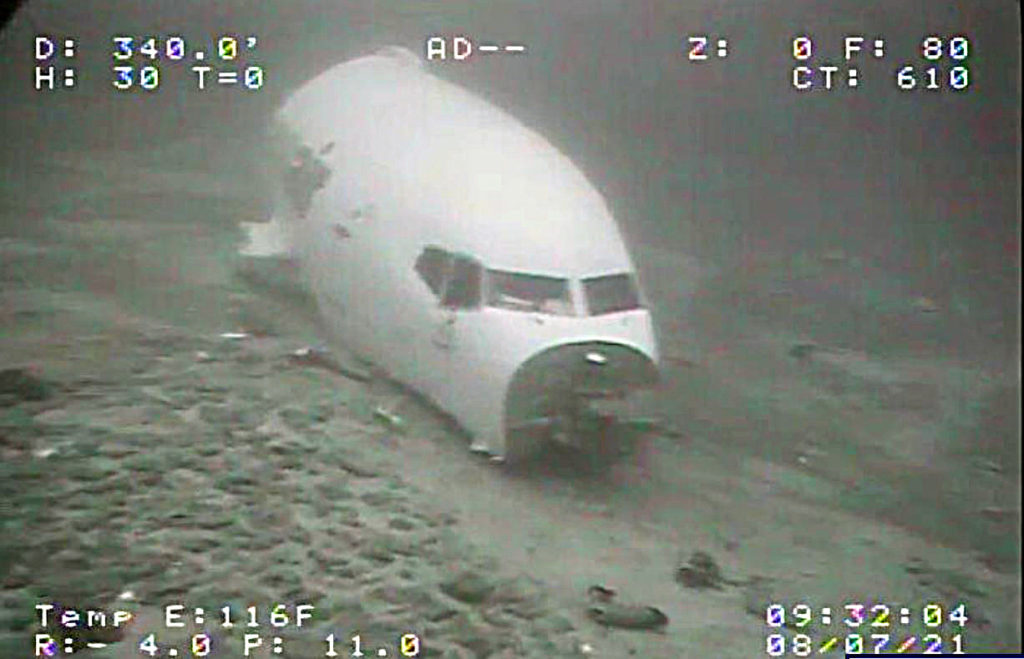MH370: Impact with the sea (ditching)
Did the MH370 ditch into the sea?

Only three debris items are 100% certified to be from MH370.

MH370 ditching: 100% means that part serial numbers were fully identified upon them. These three debris items have in common the trailing edges (rear edges) been broken off.
Right wing flaperon

The trailing edge is missing.
Inner part of right wing outer flap

The trailing edge is missing too, there is a rupture shape similar with flaperon.
Left wing outer flap

Only the trailing edge has been recovered.

OBSERVATION:
There is a similitude between the right wing & the Inner part of right wing outer flap damage. This can imply that they experienced a similar event. If we assume water impact, then they were together when they hit the water.
The right wing flaperon examined by the French authorities appears to have its attachments to the wing broken. Probably from lateral or torsional loads, not just direct hydrodynamic loads.
COMMENT from Aeronautical design:
Aeronautical attachments are optimal for the support they are supposed to give. They are made to break when loaded in ways that would result in aircraft structural damage unless they break.
The examining authorities considered Six debris items to be “almost certainly” from the MH370
The right wing aileron was completely ripped off from its attachments by pure tension.
The examining authorities consider this item as one of the five debris items which are “almost certainly” from the MH370 (picture below).


Right wing flaperon and inner flap attachments to fail in this catastrophic way can be due to combined loads. Probably due to hydrodynamic loads and large wing deformations and/or fracture of the wing.
This can imply an impact of the aircraft with the sea at a large roll rotation and appropriate speed.

Impact of the right wing tip with the sea resulting in the ripping off of the right aileron,

Then violent impact of the rest of the right wing suffering large deformations from the hydrodynamic forces. They will break the flap attachments and lead to possible failure of the wing near the flaperon section. This would release the flaperon and the flap.
“… Wing failure occurred at 154.4% from our initial readings. Failure occurred in both wings, so again analyzing data afterwards we determined that they failed 20 milliseconds apart; right wing going first. Additional analysis after that showed that the right wing failed beginning in the area of rib 25 …”, “… This test, at destruction, we failed at approximately 24 feet tip deflection of the wing …”
Extract from the Boeing B777 certification test
This is about 7.3 meters tip deflection.






To my understanding, Rib 25 area appears to be in the vicinity between the inner part of the outer flap and the right engine support pylon, close to the flaperon.

(There was the discovery in August 2020 at Jeffreys Bay, SA, of a (presumed) part of MH370. It was appears to be the Inboard Spoiler (adjacent to the Flaperon) with its attachments broken off. This suggests that wing fracture occurred in the vicinity of this area releasing both the spoiler part and the flaperon. Mike Exner and Don Thompson produced a technical note and concluded a similar fate for the wing. However, in their theory, it was due to flutter or divergence during uncontrolled descend, not due to a sea impact.)

It follows a large aircraft yaw to the right (pivoting around the deforming right wing). Then impact of the aircraft frontal fuselage underbelly releasing (at least) the right-hand nose gear forward door.
Damage of the frontal part of the fuselage/cabin that might lead to its rupture. This at the level of the attachment to the “central wing-box” (junction between wing and fuselage).
Release of the right engine from its supports due to the large vertical and axial hydrodynamic loads.
Evidence from the cowling debris failure mode (bi-axial tension) that suggests internal hydrodynamic over-pressure.
Released engine and associated debris possibly moving backwards over the right wing. Then impacting the right horizontal stabilizer and the vertical tail fin.
Damage or eventual rupture of the rear part of the fuselage/cabin at the level behind the junction with the wing, but difficult to quantify.

Finally the main aircraft wreckage could consist of four parts:

- The right wing part from the engine pylon (Rib 25 area) outwards.
- The front part of the fuselage heavily damaged or detached.
- The right engine.
- The central fuselage with the root of the right wing, the entire left wing plus maybe the left engine. And maybe the rear fuselage with the tail-fin and right stabilizer heavily damaged, all as one piece.
The Inmarsat data analyzed by Boeing suggest that MH370 run out of fuel before plunging into the ocean. Ie. both engines inoperative.
No authorities have reported any floating mass of debris anywhere in the Indian ocean following the disappearance of MH370. This leads us to exclude a possible uncontrolled dive or water impact similar to the AirFrance Rio-Paris A330 accident. Which in fact had figured vertical speed of about 11000 ft/min.
My appreciation of the debris evidence is that the MH370 has been somehow piloted to the very end in attempted but missed controlled ditching.
The next step is to estimate the most probable ditching setup for the aircraft. This would be in terms of pitch / yaw angles and vertical / horizontal speeds upon impact. Possibly also for the sea state most compatible to the night of the event. In this respect I laid down a theoretical foundation in 2020 that I published with a scientific paper in the AIAA AVIATION 2021 FORUM. I shall link this theoretical paper with the one I published for the flaperon. I will use it to assess what ditching conditions would lead first to the right flaperon trailing edge rupture. At the same time to the right wingbox rupture that would eventually liberate the rest of the right flaperon and right inner flap from their attachments. When I shall conclude this investigation, I will make it available in this website. Regrettably, due to personal constraints, I had to pause this investigation until now. But I hope to restart it in the near future.
Meanwhile, since I performed the above work in 2020, the following incident occurred. It involved the Transair Flight 810 Boeing 737 Cargo on the 2nd July 2021. It offers a remarkable resemblance with the MH370 breakup I proposed in this chapter. I enclose the immediate message from Reuters that day as below:
WASHINGTON (Reuters) – Investigators have located a Boeing 737-200 cargo jet that made an emergency water landing off the Hawaiian island of Oahu in the Pacific Ocean on July 2, the National Transportation Safety Board said on Friday. They found Transair Flight 810 approximately 2 miles offshore from Ewa Beach. The major components of the airplane — the aft fuselage including both wings and tail along with both engines, and forward fuselage — were located on the sea floor at depths between 360 and 420 feet, the NTSB said in a statement.

The main and aft fuselage with the wings as one piece, while the forward fuselage missing.

The detached forward fuselage.

A part of an engine detached.
Another extract from the news media of that day:
Air-ground communications indicated that the aircraft was suffering engine failure. It was unable to hold altitude as the crew attempted to return to Honolulu. Both pilots were injured but survived the accident. The aircraft was badly damaged and sank, although a “small amount” of floating debris has been retrieved.
In the case of MH370, a “small amount” of floating debris was retrieved. We suspect a missed ditching that resulted in the breakup of the aircraft in 4 major parts, as I depicted in this chapter further above, and the sinking of the aircraft …

